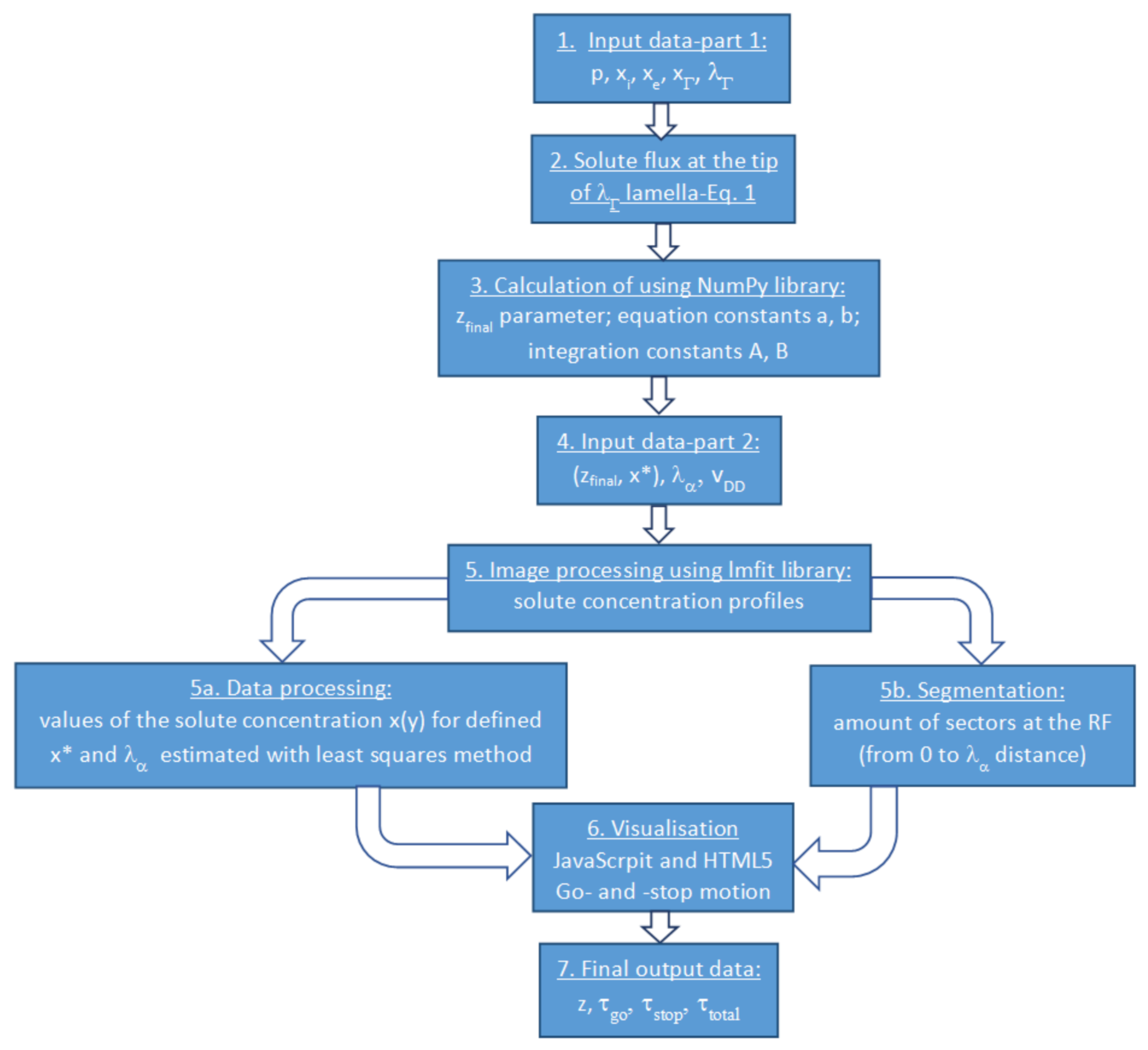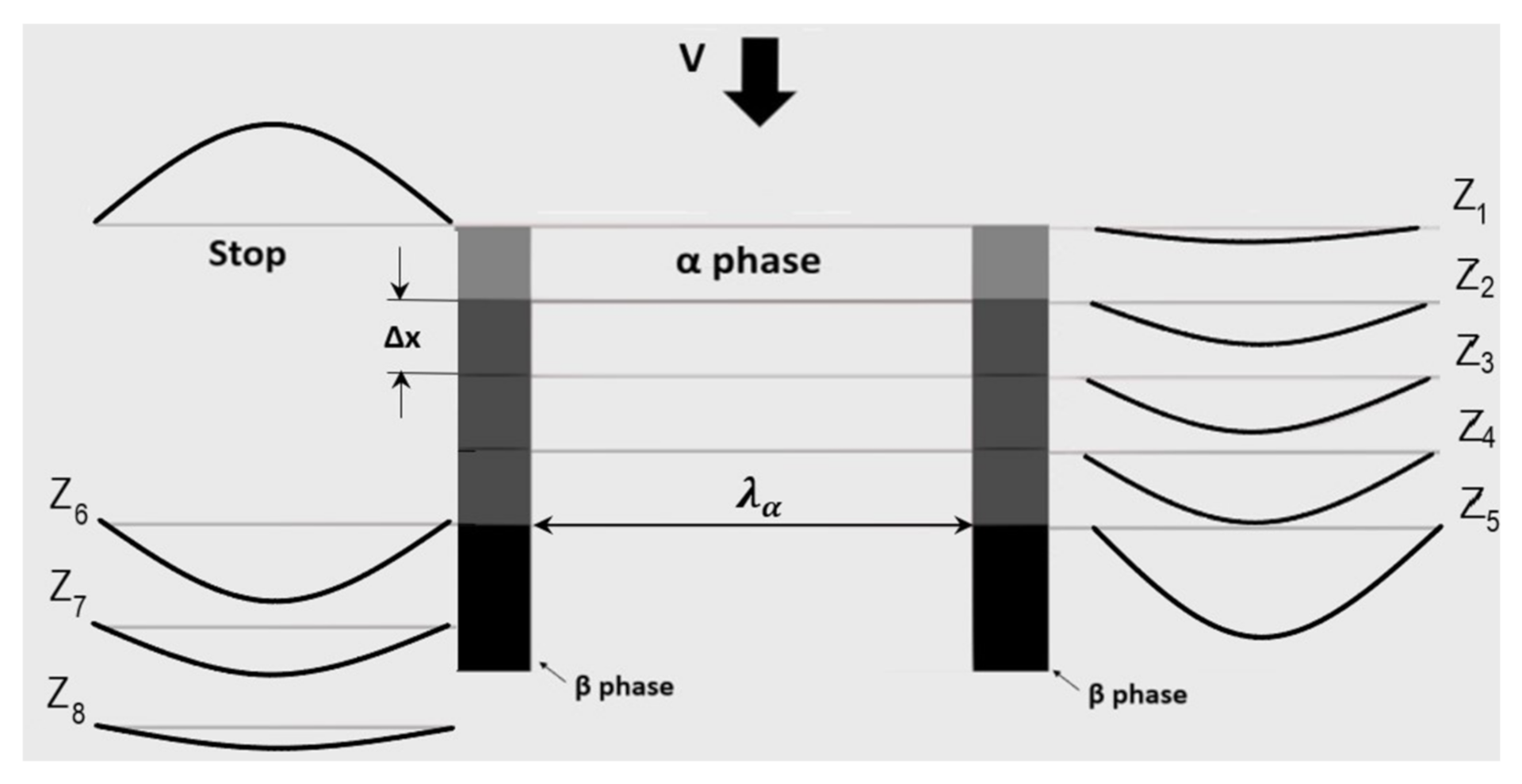Jerky Motion of the Reaction Front during Discontinuous Dissolution in a Fe-13.5 at.% Zn Alloy
Abstract
:1. Introduction
2. Simulation Procedure
3. Results
4. Discussion
5. Conclusions
- The Zn concentration profile (existing in the α phase lamellae after the former DP process) has only a little influence on the occurrence of this phase transformation and can be neglected in the simulation procedure.
- The DD reaction takes place by a jerky motion of the receding reaction front, which can be described as subsequent go- and -stop events.
- The time of the go- and -stop periods is relatively long and decreases with an increase in dissolution rate. The opposite tendency holds true for the values of movement distances and z parameters.
- The time of a go- event is longer for higher values of x* left behind the receding tip of the Γ lamellae. On the other hand, the stop period is mostly dependent on x* values for the constant dissolution rate.
- The simulation is the only source of data for z parameter changes during the stop period of the DD reaction. Knowledge of the z parameter values makes it possible to restore the Zn concentration profiles left in the post-dissolution area.
Author Contributions
Funding
Data Availability Statement
Acknowledgments
Conflicts of Interest
References
- Moelans, N.; Zhang, Y.B.; Godfrey, A.; Juul Jensen, D. A phase-field simulation study of irregular grain boundary migration during recrystallization. IOP Conf. Ser. Mater. Sci. Eng. 2015, 89, 012037. [Google Scholar] [CrossRef] [Green Version]
- Prieto-Depedro, M.; Martin-Bragado, I.; Segurado, J. An atomistically informed kinetic Monte Carlo model of grain boundary motion coupled to shear deformation. Int. J. Plast. 2015, 68, 98–110. [Google Scholar] [CrossRef] [Green Version]
- Cheng, K.; Zhang, L.; Lu, C.; Tieu, K. Coupled grain boundary motion in aluminium: The effect of structural multiplicity. Sci. Rep. 2016, 6, 25427. [Google Scholar] [CrossRef] [PubMed] [Green Version]
- Den Broeder, F.J.A. Diffusion-induced grain boundary migration and recrystallization, exemplified by the system CuZn. Thin Solid Film. 1985, 124, 135–148. [Google Scholar] [CrossRef]
- Chongmo, L.; Hillert, M. A metallographic study of diffusion-induced grain boundary migration in the Fe-Zn system. Acta Metall. 1981, 29, 1949–1960. [Google Scholar] [CrossRef]
- Ma, C.Y.; Rabkin, E.; Gust, W.; Hsu, S.E. On the kinetic behaviour and driving force of diffusion induced grain boundary migration. Acta Metall. Mater. 1995, 43, 3113–3124. [Google Scholar] [CrossRef]
- Abdou, S.; Solorzano, G.I.; El-Boragy, M.; Gust, W.; Predel, B. In-situ study of discontinuous precipitation in Al-15 at.% Zn. Scr. Mater. 1997, 34, 1431–1436. [Google Scholar] [CrossRef]
- Sulonen, M.S. Discontinuous mode of dissolution of a β phase precipitate into α Cu-Cd solid solutions. Acta Metall. 1960, 8, 669–676. [Google Scholar] [CrossRef]
- Chuang, T.H.; Fournelle, R.A.; Gust, W.; Predel, B. Drei diskontinuierliche Festkörperreaktionen in einer a-Fe-13.5 At.-% Zn-Legierung. Int. J. Mater. Res. 1989, 80, 318–326. [Google Scholar] [CrossRef]
- Chronowski, M.; Zięba, P. On the go-and-stop motion of the discontinuous precipitation front. Arch. Civ. Mech. Eng. 2020, 20, 35. [Google Scholar] [CrossRef] [Green Version]
- Chronowski, M.; Opara, J.; Kogtenkova, O.; Druzhinin, A.V.; Zięba, P. Prediction of solute concentration gradients during growth of discontinuous precipitates in a Fe-13.5 at.% Zn alloy. Mater. Lett. 2021, 301, 130317. [Google Scholar] [CrossRef]
- Cahn, J.W. The kinetics of cellular segregation reactions. Acta Metall. 1959, 7, 18–28. [Google Scholar] [CrossRef]
- Zięba, P.; Opara, J.; Chronowski, M.; Kogtenkova, O.; Straumal, B. Discontinuous dissolution reaction in a Fe-13 at.% Zn alloy. Materials 2021, 14, 1939. [Google Scholar] [CrossRef] [PubMed]
- Zięba, P.; Chronowski, M.; Morgiel, J. Micro-analytical studies of discontinuous precipitation in Fe-13.5 at.% Zn alloy. Arch. Civ. Mech. Eng. 2020, 20, 76. [Google Scholar] [CrossRef]
- Zięba, P.; Pawłowski, A. Analysis of cellular dissolution model. Scr. Metall. 1986, 20, 1653–1656. [Google Scholar] [CrossRef]
- Hackney, S.A.; Biancaniello, F.S. Directional invariance of grain boundary migration in the Pb-Sn cellular transformation and the Tu-Turnbull hysteresis. Scr. Metall. 1986, 20, 1417–1422. [Google Scholar] [CrossRef]


| Stage of Motion | z × 106 (m−1) | C Parameter | |
|---|---|---|---|
| Cmin = 1.74 | Cmax = 7.23 | ||
| Go | z1 | 1.03 | 1.20 |
| z2 | 1.11 | 1.32 | |
| z3 | 1.22 | 1.45 | |
| z4 | 1.51 | 1.66 | |
| z5 | 1.97 | 1.80 | |
| stop | z6 | 1.59 | 1.44 |
| z7 | 1.29 | 1.29 | |
| z8 | 1.05 | 111 | |
| Cmax = 7.23 | |||
| Zn-content at the β tip (at.% Zn) | x* = 16 | x* = 20 | x* = 25 |
| τgo (s) | 15 | 20 | 31 |
| τstop (s) | 8 | 12 | 19 |
| Movement distance (μm) | 5.3 | 6.1 | 6.9 |
| Parameter z (1/m) | 1.8 × 106 | 1.84 × 106 | 1.95 × 106 |
| Cmin = 1.74 | |||
| Zn-content at the β tip (at.% Zn) | x* = 16 | x* = 20 | x* = 25 |
| τgo (s) | 15 | 22 | 38 |
| τstop (s) | 8 | 14 | 22 |
| Movement distance (μm) | 5.4 | 6.2 | 7.3 |
| Parameter z (1/m) | 1.97 × 106 | 2.02 × 106 | 2.14 × 106 |
| Stage | Time (s) | Parameter z × 106 (m−1) | Movement Distance (μm) |
|---|---|---|---|
| v = 420 nm/s, λα = 150 nm | |||
| Go | 1 | 1.04 | 0.42 |
| 2 | 1.10 | 0.84 | |
| 3 | 1.18 | 1.26 | |
| 4 | 1.24 | 1.68 | |
| 5 | 1.30 | 2.10 | |
| 6 | 1.49 | 2.52 | |
| 7 | 1.57 | 2.94 | |
| 8 | 1.66 | 3.36 | |
| 9 | 1.79 | 3.78 | |
| 10 | 1.93 | 4.20 | |
| Stop | 11 | 2.11 | 4.62 |
| 12 | 1.89 | 4.62 | |
| 13 | 1.56 | 4.62 | |
| 14 | 1.36 | 4.62 | |
| 15 | 1.22 | 4.62 | |
| 16 | 1.11 | 4.62 | |
| 17 | 1.00 | 4.62 | |
| v = 50 nm/s, λα = 150 nm | |||
| Go | 5 | 1.14 | 0.25 |
| 10 | 1.28 | 0.50 | |
| 15 | 1.34 | 0.75 | |
| 20 | 1.44 | 1.00 | |
| 25 | 1.59 | 1.25 | |
| 30 | 1.68 | 1.50 | |
| Stop | 35 | 1.99 | 1.75 |
| 40 | 1.76 | 1.75 | |
| 45 | 1.65 | 1.75 | |
| 50 | 1.43 | 1.75 | |
| 55 | 1.23 | 1.75 | |
| 60 | 1.11 | 1.75 | |
| v = 5 nm/s, λα = 150 nm | |||
| Go | 10 | 1.16 | 0.05 |
| 20 | 1.30 | 0.10 | |
| 30 | 1.50 | 0.15 | |
| Stop | 40 | 1.83 | 0.20 |
| 50 | 1.49 | 0.20 | |
| 60 | 1.26 | 0.20 | |
| 70 | 1.13 | 0.20 | |
| v = 0.5 nm/s, λα = 150 nm | |||
| Go | 10 | 1.20 | 0.005 |
| 20 | 1.32 | 0.010 | |
| 30 | 1.45 | 0.015 | |
| 40 | 1.66 | 0.020 | |
| Stop | 50 | 1.80 | 0.025 |
| 60 | 1.44 | 0.025 | |
| 70 | 1.29 | 0.025 | |
| 80 | 1.11 | 0.025 | |
| Receding Rate (nm/s) | Thickness of λ Lamella λα = 150 nm | |||||||||||
|---|---|---|---|---|---|---|---|---|---|---|---|---|
| x* = 16 at.% Zn | x* = 20 at.% Zn | x* = 25 at.% Zn | ||||||||||
| Go (s) | Stop (s) | Distance (μm) | z × 106 (m−1) | Go (s) | Stop (s) | Distance (μm) | z × 106 (m−1) | Go (s) | Stop (s) | Distance (μm) | z × 106 (m−1) | |
| 0.5 | 50 | 30 | 0.025 | 1.80 | 60 | 50 | 0.03 | 1.84 | 80 | 40 | 0.04 | 1.95 |
| 5.0 | 40 | 30 | 0.20 | 1.83 | 60 | 40 | 0.3 | 1.9 | 70 | 40 | 0.35 | 1.99 |
| 50 | 35 | 25 | 1.75 | 1.99 | 40 | 25 | 4.0 | 2.0 | 45 | 25 | 4.5 | 2.11 |
| 420 | 11 | 6.0 | 4.62 | 2.11 | 14 | 5.0 | 5.88 | 2.26 | 16 | 7.0 | 6.72 | 2.34 |
| Thickness of λ Lamella λα = 300 nm | ||||||||||||
| 0.5 | 53 | 32 | 0.0265 | 1.84 | 62 | 51 | 0.031 | 1.93 | 85 | 40 | 0.0425 | 2.13 |
| 5.0 | 47 | 36 | 0.235 | 1.91 | 60 | 43 | 0.300 | 2.00 | 79 | 40 | 0.395 | 2.24 |
| 50 | 38 | 28 | 1.9 | 2.02 | 43 | 28 | 2.15 | 2.12 | 49 | 25 | 2.45 | 2.44 |
| 420 | 12 | 7.2 | 5.04 | 2.13 | 18 | 6.4 | 7.56 | 2.35 | 19 | 7.0 | 7.98 | 2.77 |
Publisher’s Note: MDPI stays neutral with regard to jurisdictional claims in published maps and institutional affiliations. |
© 2022 by the authors. Licensee MDPI, Basel, Switzerland. This article is an open access article distributed under the terms and conditions of the Creative Commons Attribution (CC BY) license (https://creativecommons.org/licenses/by/4.0/).
Share and Cite
Chronowski, M.; Opara, J.; Straumal, B.; Baretzky, B.; Zięba, P. Jerky Motion of the Reaction Front during Discontinuous Dissolution in a Fe-13.5 at.% Zn Alloy. Materials 2022, 15, 3525. https://doi.org/10.3390/ma15103525
Chronowski M, Opara J, Straumal B, Baretzky B, Zięba P. Jerky Motion of the Reaction Front during Discontinuous Dissolution in a Fe-13.5 at.% Zn Alloy. Materials. 2022; 15(10):3525. https://doi.org/10.3390/ma15103525
Chicago/Turabian StyleChronowski, Mateusz, Jarosław Opara, Boris Straumal, Brigitte Baretzky, and Pawel Zięba. 2022. "Jerky Motion of the Reaction Front during Discontinuous Dissolution in a Fe-13.5 at.% Zn Alloy" Materials 15, no. 10: 3525. https://doi.org/10.3390/ma15103525







